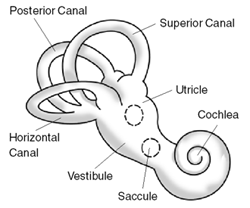Labyrinth (inner ear)
|
|
- For more uses of the word labyrinth, see Labyrinth (disambiguation)
The labyrinth is a system of fluid passages in the inner ear, comprising the vestibular system and the auditory system, which provides the sense of balance. It is named by analogy with the mythical maze that imprisoned the Minotaur, because of its appearance.
The vestibule is the region of the inner ear where the semicircular canals converge, close to the cochlea (the hearing organ). The vestibular system works with the visual system to keep objects in focus when the head is moving. Joint and muscle receptors also are important in maintaining balance. The brain receives, interprets, and processes the information from these systems that control our balance.
Interference with or infection of the Labyrinth can result in a syndrome of ailments called Labyrinthitis. The symptoms of Labrynthitis include temporary nausea, disorientation, vertigo, and dizziness. Labyrinthitis can be caused by viral infections, bacterial infections, or physical blockage of the inner ear.
bg:Вестибуларен апарат it:Labirinto (anatomia)
| Nervous system - Sensory system |
| Visual system - Auditory system - Olfactory system - Gustatory system - Somatosensory system |

